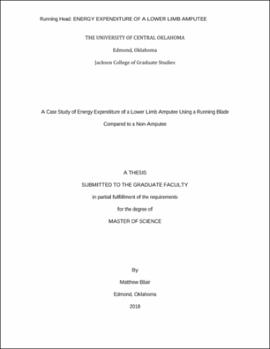| dc.contributor.advisor | Olson, Jacilyn | |
| dc.contributor.author | Blair, Matthew | |
| dc.date.accessioned | 2020-07-09T14:41:44Z | |
| dc.date.available | 2020-07-09T14:41:44Z | |
| dc.date.issued | 2018 | |
| dc.identifier.other | (AlmaMMSId)9982642371902196 | |
| dc.identifier.uri | https://hdl.handle.net/11244/325141 | |
| dc.description.abstract | The purpose of this case study was to determine if energy expenditure of a lower limb amputee (LLA) with a running specific prosthesis would be different from an able-bodied person. There is little research on running specific prosthesis and energy expenditure compared to an able-bodied person. There, were two participants (1-amputee, 1-able-bodied). Data was collected from the LLA first and then able-bodied participant was recruited as closely to match based on height, age, and sex. The modified Costill/Fox Protocol was used as the testing method. The participants started with a light warm-up on the treadmill at a speed of 3.1 mph for 4 minutes. The protocol includes the speed in mph to increase every 4 minutes (5.9, 7.5, 8.4, & 9.9). When the participant reaches an RPE of 13 the speed stayed constant and the grade increased 2% every 2 minutes until exhaustion. The Parvo-Medics was used to measure gas exchange. Both the LLA and the able-bodied participant made it to stage 3 of the modified Costill/Fox protocol. In stage 3 VO2 for the LLA was 29.6ml/kg/min, able-bodied participant was 35.9ml/kg/min, and the calculation intensity is 38ml/kg/min. The percent difference shows that the LLA was 19.2% lower when compared to the able-bodied participant. When the LLA was compared to the calculation the percent difference showed the LLA was 24.9% lower than the calculation. While no statistical comparison was made, the case study indicates that this LLA did not expend more energy that the matched control or the metabolic calculation. It appears this is the first study to directly compare the RSP to an able body participant and leads the way for future studies. | |
| dc.rights | All rights reserved by the author, who has granted UCO Chambers Library the non-exclusive right to share this material in its online repositories. Contact UCO Chambers Library's Digital Initiatives Working Group at diwg@uco.edu for the permission policy on the use, reproduction or distribution of this material. | |
| dc.subject.lcsh | Artificial legs | |
| dc.subject.lcsh | Running | |
| dc.subject.lcsh | Artificial legs | |
| dc.subject.lcsh | Running | |
| dc.title | A case study of energy expenditure of a lower limb amputee using a running blade compared to a non-amputee. | |
| dc.type | Academic theses | |
| dc.contributor.committeeMember | Fink, Kevin | |
| dc.contributor.committeeMember | Holmes, Tawni | |
| dc.thesis.degree | M.S., Kinesiology and Health Studies | |
| dc.subject.keywords | Amputee | |
| dc.subject.keywords | Energy expenditure | |
| dc.subject.keywords | Lower limb amputee | |
| dc.subject.keywords | Prosthetic | |
| dc.subject.keywords | Running blade | |
| dc.identifier.oclc | (OCoLC)1099796570 | |
| thesis.degree.grantor | Jackson College of Graduate Studies. | |
